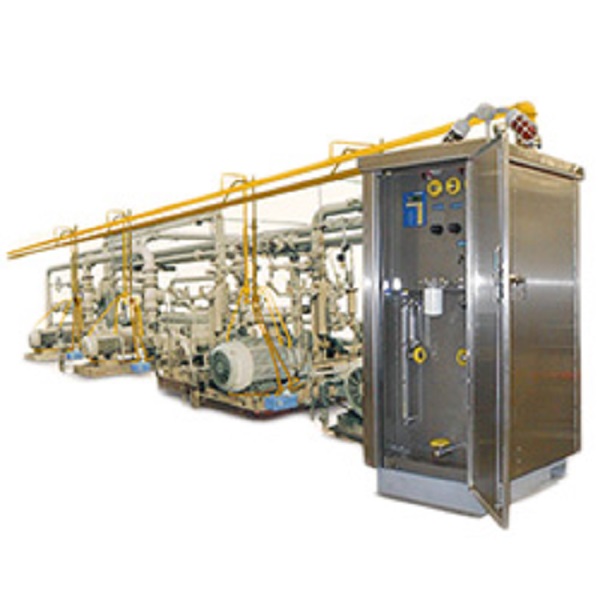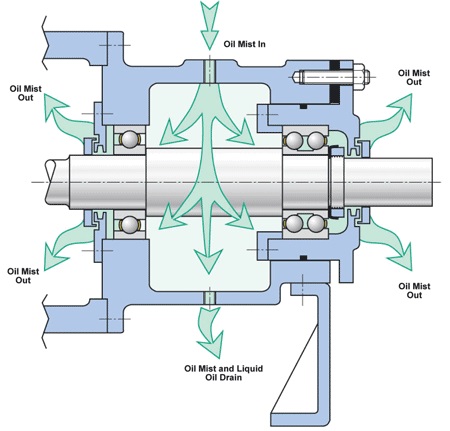History Of Oil Mist Lubrication
The Oil Mist principle was developed by a bearing manufacturer in Europe during the 1930s. The problem that nurtured this development was the inability to satisfactorily lubricate high-speed spindle bearings on grinders and similar equipment. The speed of these bearing was too high for grease lubrication, and liquid oil generated too much heat through fluid friction, necessitating an expensive recirculating system. Continuous thin-film lubrication with Oil Mist provided a solution. The purging and slight cooling effects of the carrier air gave additional benefits. The Oil Mist generator resulted later from this development and used a small amount of air to produce a dense concentration of small oil particles. About 97% of these particles could be transmitted to the bearings without condensing in the piping, regardless of the distance of the bearings from the Oil Mist generator itself.
In 1958, air heaters were developed because it was discovered that, by heating the air used to generate Oil Mist, oils of just about any viscosity could be atomized. Many applications, subject to extremes in ambient temperature, use air heaters to ensure a constant oil/air ratio regardless of the oil viscosity. Today Oil Mist is still used to lubricate high speed spindles in grinders. Included in the increasing range of Oil Mist applications are systems applied to all types of other machine tools, web and sheet processing equipment, belt and chain conveyors rolling mills, vibrators, crushers, centrifuges, kilns, pulverizers, ball mills, dryers and liquid processing pumps.
Mist Generator Systems
Oil Mist is a centralized system in which the energy of compressed gas, usually air taken from the plant supply, is used to atomize oil. Oil is then conveyed by the air in a low pressure distribution system to multiple points of lubricant application.
The compressed air is passed through a venturi. Oil, siphoned from a reservoir by the air flow, is atomized into a fine spray. Baffles downstream from the venturi nozzle causing the larger oil particles to coalesce and return to the reservoir. The remaining air-oil-mixture is Oil Mist. Oil Mist contains oil particles (droplets) averaging about 1-1/2 microns in diameter (.00006 inches), which can be conveyed through distribution piping (mist manifold), at velocities up to 24 feet per second, to application fittings (mist fittings which meter oil to bearing housings). Air-borne oil particles are then “wetted out” by impinging upon bearing surfaces rotating at sufficient speed to cause adherence and the formation of larger drop sizes. Because there are no moving parts in the basis Oil Mist generator system, and because the system pressure is very low (manifold pressures from 5 to 40 inches of water), it is a reliable lubrication method. Also, the system can be interlocked with machine operation or an alarm system to ensure proper functioning. Note that, even when malfunctions occur, most bearings will operate for hours on an existing film of lubricant.
Principle Of Oil Mist Generation
Advantages Of Oil Mist
This system is ideal in that a metered amount of oil (approaching optimum) can be provided to the bearing for proper lubricity. Lubricant friction itself is virtually eliminated. Keep in mind that grease is used only as a “carrier” for those oils within it which provide lubricity. Other than that, it is an impediment to rotation, causes frictional heat, can carry and recycle abrasive particles to the bearing, and doesn’t guarantee good dispersion (i.e., coating of all surfaces of the bearing at all times to prevent corrosion).
The oil mist provides a flushing action with fresh, clean lubricant and acts in a slight manner as a bearing coolant. The carrier air used to distribute the oil provides additional benefits in that it maintains bearing housings under slight positive pressure and the “outward” air flow prevents the entrance of contaminants. Where mist systems run continuously – and when motors are inoperative – problems with condensation reaching bearing surfaces are eliminated.
Maintenance “human factor” problems are reduced: Over-greasing, lack of replenishment of the proper grease and the right amount at the right time.
Source: acim.nidec












